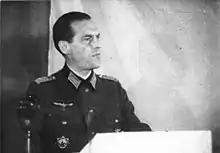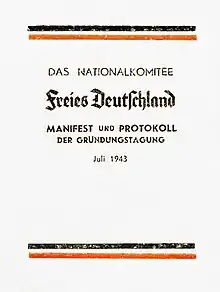German: Nationalkomitee Freies Deutschland | |
 | |
| |
| Abbreviation | NKFD |
|---|---|
| Formation | 12 July 1943[4]: 51–61 |
| Founded at | Lunjowo POW camp 27, Krasnogorsk, Moscow Oblast[5] |
| Dissolved | 2 November 1945 |
| Type | Liberation committee |
| Purpose |
|
President | Erich Weinert[6] |
Key people | Gerhard Bechly[4][7] Walther von Seydlitz-Kurzbach |
Main organ | Freies Deutschland im Bild |
| Affiliations | Bund Deutscher Offiziere |
The National Committee for a Free Germany (German: Nationalkomitee Freies Deutschland, or NKFD) was a German anti-Nazi organisation that operated in the Soviet Union during World War II.[8][9]
History
The rise of the Nazi Party to power in Germany in 1933 led to the outlawing of the Communist Party of Germany (KPD) and persecutions of its members, many of whom fled to the Soviet Union.
With the German invasion of the Soviet Union in Operation Barbarossa, German prisoners of war began to fall into Soviet hands. Attempts to establish an anti-Nazi organization from these POWs.
With the German defeat at the Battle of Stalingrad, the number of German POWs increased and their belief in a victorious Germany weakened, hence they were more open to the idea of membership of an anti-Nazi organization.
At the beginning of June 1943, Alfred Kunella and Rudolf Herrnstadt began writing a Committee manifesto.[10] This text praised historical figures from the Kingdom of Prussia who had allied with Imperial Russia against Napoleon in the German Campaign of 1813; figures such as Heinrich Friedrich Karl vom und zum Stein, Carl von Clausewitz and Graf Yorck were depicted as exemplary Germans. The National Committee for a Free Germany (NKFD) was founded in Krasnogorsk, near Moscow,[5]: 120 on 12 July 1943; its president was the exiled German communist writer Erich Weinert, with his deputies Lieutenant Heinrich Graf von Einsiedel and Major Karl Hetz. Its leadership consisted of 38 members, including 28 Wehrmacht POWs and 10 exiled communists including Friedrich Wolf.
League of German Officers

After several failed attempts to recruit officers into the NKFD, it was suggested by Lieutenant-Colonel Alfred Brette that a special organization for officers be set up so that they would not have to come into contact with communists and common soldiers.
Two months after the founding of the NKFD, the League of German Officers (Bund Deutscher Offiziere, or BDO) was founded; its leader was General Walther von Seydlitz-Kurzbach. The main task of the BDO was to deliver propaganda aimed at the German armed forces. A number of officers held as Soviet prisoners of war eventually joined the BDO, the most prominent of them being Field-Marshal Friedrich Paulus, commander of the Sixth Army captured at the Battle of Stalingrad. The BDO later merged with the NKFD.[11][12]
Ideology
.svg.png.webp)
_1965%252C_MiNr_1106.jpg.webp)

Although the NKFD operated in the Soviet Union and consisted partly of communists, it used conservative symbols and ideology. For example, the old flag colors of Imperial Germany (black, white and red) were used instead of the Weimar German (black, red and gold), as they were expected to be more popular among officers and soldiers of the conservative Wehrmacht. The stated goal of the NKFD organisation was a return to the borders of 1937, the opening of negotiations for peace, and the deposing and punishment of the Nazi leadership.
Activity
NKFD and BDO activity focused on propaganda and had their own newspaper and radio station. They sent leaflets to German soldiers on the Eastern Front and to POWs in the Soviet camps. Red Army Major Lev Kopelev described the joint psychological warfare at Grudziądz in March 1945 by the Red Army and members of the NKFD. General Seydlitz-Kurzbach offered to raise an anti-Hitler army from NKFD and BDO members to fight against the Nazis, but the Soviet side rejected their offer.
Some NKFD members were attached to front-line Soviet units to interrogate German POWs and for propaganda purposes. Others fought behind the German lines alongside Soviet partisan units. Towards the very end of the war so-called Seydlitz-Troops were sent to the German lines in uniform with orders to blend in with the defenders and spread confusion. Some rejoined their former comrades and others followed their orders. Many were caught and executed. As the Red Army entered Germany, some NKFD members were appointed as officials in the local government of the Soviet occupation zone.
Publications
The NKFD published both a newspaper and a radio program titled "Free Germany" (German: Freies Deutschland). The newspaper's editor-in-chief was Rudolf Herrnstadt, whereas the radio program was directed by Anton Ackermann.[13]: 203 The newspaper "Free Germany" was just one of several Soviet publications aimed at the Soviet Union's prisoners of war; the effort placed into the German-language publication was however significantly larger than its various sister projects (Alba (Italian), Word of Truth (Hungarian), Free Voice (Romanian)).[13]: 93
Branch groups
Anti-Fascist Committee for a Free Germany (Greece)
Free Germany Movement for the West (France)
Post-war
After the defeat of Nazi Germany, NKFD members mostly returned to the Soviet occupation zone in Germany and had a key role in building the German Democratic Republic. Some BDO members had a key role in building the National People's Army, but others like Seydlitz were prosecuted as war criminals.
Notable members
- Anton Ackermann
- Wilhelm Adam
- Johannes R. Becher
- Gerhard Bechly
- Willi Bredel
- Heinrich Graf von Einsiedel
- Wilhelm Florin
- Peter Gingold
- Heinz Kessler
- Alfred Kurella
- Arno von Lenski
- Wolfgang Leonhard
- Vincenz Müller
- Friedrich Paulus
- Wilhelm Pieck
- Theodor Plievier
- Hermann Rentzsch
- Willy Riedel
- Walther von Seydlitz-Kurzbach
- Walter Ulbricht
- Gustav von Wangenheim
- Erich Weinert
- Otto Winzer
- Friedrich Wolf
- Markus Wolf
See also
- National Committee for the Liberation of Yugoslavia
- National Committee of the Republic of Estonia
- Supreme Committee for the Liberation of Lithuania
- Committee for the Liberation of the Peoples of Russia
- Japanese People's Emancipation League
- Italian resistance movement
- Lev Kopelev
- Free Albania National Committee
Notes and references
- ↑ spiegel.de Das Dilemma des Genossen Graf (German)
- ↑ WALTHER VON SEYDLITZ-KURZBACH
- ↑ Names according to Leonid Reschin: General von Seydlitz in sowj. Haft 1943–1955, ISBN 3-8289-0389-4
- 1 2 The Free Germany movement: a case of patriotism or treason?, by Kai P. Schoenhals, Greenwood Press, 1989
- 1 2 Crüger, H.; Ehlert, A.; Köhler, J.; Nadolny, J. (1990). Verschwiegene Zeiten: vom geheimen Apparat der KPD ins Gefängnis der Staatssicherheit. Linksdruck. p. 120. ISBN 9783861530022. Retrieved 2015-01-06.
- ↑ "Weinert, Erich". The Free Dictionary. Retrieved 7 March 2013.
- ↑ Ich Bitte Erschossen Zu Werden, Der Spiegel, December 2, 1949, page 16
- ↑ Political Affairs By Earl Browder, Trade Union Unity League (U.S.), Herbert Aptheker, Communist Party of the United States of America, Gus Hall Published 1927 New Century Publishers Communism Original from the University of California Digitized 7 February 2007
- ↑ The Russians in Germany: A History of the Soviet Zone of Occupation, By Norman M. Naimark Published 1995 Harvard University Press Communism and culture/ Germany (East) 586 pages ISBN 0674784057
- ↑ "Deutsches Historisches Museum: Fehler2 | The manifesto in German". dhm.de. Retrieved 2015-01-06.
- ↑ Müller-Enbergs, H. (1991). Der Fall Rudolf Herrnstadt: Tauwetterpolitik vor dem 17. Juni. LinksDruck Verlag. p. 39. ISBN 9783861530039. Retrieved 2015-01-06.
- ↑ ""Ich bitte erschossen zu werden". By Philipp Humbert", Der Spiegel (in German), no. 5, pp. 15–18, 1949-01-29
- 1 2 Morré, Jörg (2001). Hinter den Kulissen des Nationalkomitees: Das Institut 99 in Moskau die Deutschlandpolitik der UdSSR 1943–1946. Munich: R. Oldenbourg Verlag. ISBN 348664582X.
Further reading
- Lev Kopelev, To Be Preserved Forever ("Хранить вечно"), 1976


_1965%252C_MiNr_1107.jpg.webp)